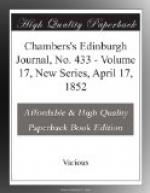The foregoing narrative, true in every respect, is drawn up by us from documents issued under the authority of the Russian government. It shews, in a convincing manner, that subsistence is by no means impossible for sailors wrecked and icebound within the polar regions.
WILD ANIMALS IN CONFINEMENT.
Were it not that custom reconciles us to everything, a Christian community would surely be shocked by the report, and still more by the sight, of the sacrifice of innocent and helpless creatures—pigeons and rabbits, for instance—to the horrible instincts of snakes, who will not eat anything but what is alive. An account was recently given of a night-visit to the place of confinement of these disgusting reptiles, in which the evident horror of their intended victims, confined in the same cages, was distinctly mentioned. The gratification of mere curiosity does not justify the infliction of such torture on the lower animals. Surely the sight of a stuffed boa-constrictor ought to content a reasonable curiosity. Imagine what would be felt if a child were subjected to such a fate, or what could be answered if the present victims could tell their agonies as well as feel them! Byron speaks of the barbarians who, in the wantonness of power, were ‘butchered to make a Roman holiday;’ and verily the horrors exhibited in our public gardens and menageries are something akin to the fights of gladiators; it is the infliction of misery for mere sport. With reference also to lions, tigers, and other ferocious animals kept in cages—if retained at all, the space allotted them ought to be much larger than it is, so as to allow them full room for healthful exercise. At present, they must be wretched; and considering also the quantity of food they consume, which might be converted to useful purposes—though this is taking a lower view of the matter—it is at least desirable that the number should be much smaller, and a much greater space allowed them to exhibit their natural vivacity. These remarks do not, of course, apply to fowls and other animals who are allowed a sufficient share of liberty to exist in comfort, and to whom it is not necessary to sacrifice the existence of other creatures.—Ogden’s Friendly Observer.
[We entirely agree in reprobating the practice of placing live rabbits and other creatures within the cages of boa-constrictors. A recollection of a poor little rabbit cowering in the corner of one of these cages, as if aware of its approaching fate, has haunted us for years. No purpose of science can be answered by this constantly recurring barbarity. Zoological Societies should be careful not to run any risk of counteracting by such spectacles the elevated feelings they are so well calculated to foster.—Ed. C. E. J.]
* * * * *
Printed and Published by W. and R. CHAMBERS, High Street, Edinburgh. Also sold by W. S. ORR, Amen Corner, London; D. N. CHAMBERS, 55 West Nile Street, Glasgow; and J. M’GLASHAN, 50 Upper Sackville Street, Dublin.




